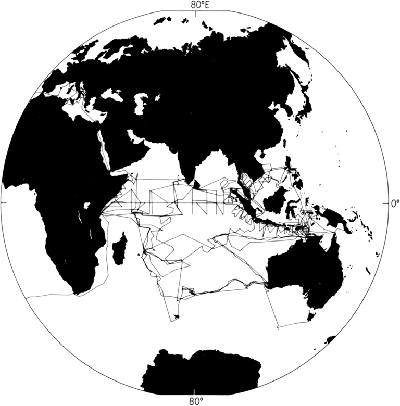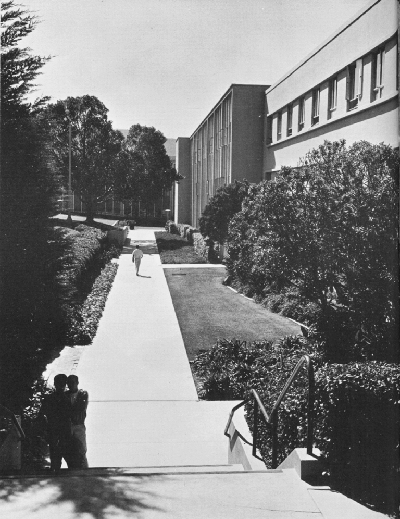IV. THE LITTLE GREEN
LABORATORY AT THE COVE
“The Little Green Laboratory at the Cove,” which was to house the work of the biological survey for the next few years, was on the whole a welcome addition to the somewhat barren La Jolla landscape. Acton and Company erected the basic wood structure for $992, and all but thirty-four dollars of this sum was provided by the La Jolla Improvement Society. The generous interest of this group, which represented a community of about 1300 people, had been largely aroused through the efforts of Fred Baker.
Dr. Fred addressed an evening meeting of the society in March of 1905, impressing on his audience of approximately fifty men, women and children the immediate and potential worth of the proposed laboratory, and added that if La Jolla didn't want the station, “we will give grounds and house too quick at Roseville.” Three hundred and twenty-five dollars was collected on the spot. The remainder, mainly in amounts of five to twenty dollars, was raised in the next few weeks with the help of Rev. J. L. Pearson of the La Jolla Union Church (Appendix C).
In view of the strain which had been placed on the scientists' relationship with E. W. Scripps during the winter, it was fortunate that new sources of income were found that spring of 1905. Although the laboratory building itself was assured by the La Jolla subscriptions, there was still no provision for the glass tanks and display cases of the museum-aquarium, which was to be the main public attraction. Eventually the requisite amount was scraped together from an assortment of individuals and from businesses interested in promoting La Jolla. Even Miss Virginia Scripps, who admitted she was “more interested in this than the scientific side,” gave $300 for museum glassware.
Perhaps the most notable contribution came from Alexander Agassiz, the eminent Harvard-based biologist who has been called “the father of modern oceanography.” Learning of the station from C. A. Kofoid, who was a member of Agassiz's six-month South Sea Expedition of 1904–1905, the noted scientist paid San Diego a visit in March of 1905. Agassiz talked with E. W. Scripps and other members of the association at Miramar Ranch, looked over the La Jolla site, and promised substantial support. He gave books and scientific apparatus worth $1500 to $2000, as well as an immeasurable boost to the morale of everyone concerned.
At the request of Baker, who appealed to him as “the most practical man amongst us,” Kofoid came to La Jolla in April to supervise the building of the laboratory. Baker himself was reluctant to take on this responsibility so soon after the fiasco of the Loma's refitting, convinced that E. W. Scripps probably thought he “hadn't the business ability to build a chicken coop.”[1] Once permission to use the land had been granted the work went quickly, and the modest wood structure was ready for use when the rest of the Berkeley contingent arrived in mid-June. Though small and simple, it was, in the words of Dr. Ritter, “far superior to any residence the station had before occupied.”
Measuring sixty by twenty-four feet over-all, the building contained three laboratories of equal size, a small library and still smaller reagent room, and an aquarium-museum for the public. For the first time there was an abundant supply of both salt and fresh water.
Living conditions were more of a problem in the dusty village of La Jolla than they had been in thriving Coronado. In a letter discussing summer plans Baker, who regretfully expressed his view that it would not be possible to board in La Jolla for less than $6 a week, suggested that the men bring sleeping bags and offered to do what he could about a “mess tent.” The single ladies were to be lodged in a two-bedroom cottage for which the monthly rent was $22.50. Since some of the assistant researchers were being paid only $40 a month, and several not connected with the university were paying their own expenses, the cost of living was a serious consideration. Nothing was more serious than the work at hand, however, and with the added advantages of piped-in sea water, steadier microscopes and a greater wealth of material due to the Loma and her more efficient collecting apparatus, there was much work to be done.
Situated as they were in a public park, with a public bathhouse a few hundred feet away, the researchers became something of a local attraction during the next few summers. On weekends San Diegans came to La Jolla by the San Diego, Pacific Beach and La Jolla Railway to picnic at the celebrated Cove, visit the Caves, and view the fishes in bottles at the “Biological.” Shells and preserved forms of sea life lined the walls of the museum-aquarium. Live specimens displayed on a long counter in the center of the room were in open containers supplied with aerated sea water from above, and reportedly were so attractive to tourists that they were sometimes slipped into pocket or picnic basket and carried off. Meanwhile the dedicated scientists and students worked in the adjoining rooms. Several times during the summer there were “Public Days,” when the laboratories were opened to visitors, the staff arranged “displays of unusual interest” and “devoted themselves to the instruction of their guests.”
Community support was important to the future plans of the Marine Biological Institution, and beyond this, Ritter and his associates sincerely believed that scientists should communicate as much of their knowledge as possible to the general public. Thus the occasional lectures that Ritter, Kofoid and others had given in the San Diego area in previous years developed into a weekly series in 1905. Members of the regular staff and visiting scientists gave popular talks and response was encouraging.
Ellen Browning Scripps, a year-round La Jolla resident now sixty-nine years old, was drawn in along with the rest of the community. She attended many of the lectures and began to take more and more interest in the project to which she had made such sizable contributions on her brother E. W.'s initial recommendation. Although she had faithfully attended directors' meetings and had taken her official responsibilities seriously, it was not until the station moved to La Jolla that she became committed to establishing the institution on an unquestionably permanent basis. In January of 1906 she quietly informed the other directors that she had decided to place $50,000 at the disposal of the association. The exact date at which the gift would be made was for the time being left indefinite, although Miss Scripps and her brother stated that possibly it would come as a bequest at the time of her death.
The announcement of the $50,000 gift came shortly before Dr. Ritter departed for the Orient on his sabbatical leave, and it was
The pledge of $50,000 from a private source also reassured the administration of the state university. President Wheeler and Judge McKinley, chairman of the regents' committee on the institution, paid a visit to La Jolla in late January of 1906 and discussed the endowment and future plans with Miss Scripps and other members of the association. They indicated their continued interest and willingness to cooperate, and in making the official visit strengthened the institution's ties with the University of California, but again refused to make any commitments for the future. In fact the final sentence of the resolution which the board of regents passed thanking Miss Scripps for the endowment set forth the strong reservation that “the acceptance of such trust does not carry with it any obligation on the part of the University of California to provide any funds for any purpose in connection with said work.”[2]
Meanwhile C. A. Kofoid, who was to direct the work of 1906 in Dr. Ritter's absence, was busily making plans for the summer session. He corresponded with a number of eastern scientists in the hope of inducing them to spend at least part of the summer in La Jolla, for the association was anxious to bring its work to the attention of scientists throughout the nation. Once the favorable conditions for marine biological research offered by the La Jolla location were recognized, it was felt, some of the most able men in the field would come to pursue their special lines of investigation. Not only would the station become better known through such contacts, it would also benefit from the findings of these men working within the scope of the survey.
Thus in 1906 Professors E. L. Mark of Harvard University, E. B. Wilson of Columbia University, and H. S. Jennings of Johns Hopkins University spent several weeks at the association's expense in the
To furnish these eminent investigators and the regular staff with material for their studies the Loma made daily collections. In 1905 the renovated schooner had made a lengthy voyage to San Clemente Island where her ability to dredge at a depth of 700 fathoms had been “conclusively proven.” Staying closer to shore in 1906 she was used in hydrographic explorations of the Soledad Submerged Valley off the La Jolla coast and in collecting plankton in water up to 400 fathoms in depth.
All went well until the evening of July 25, when the work at sea came to an abrupt halt. On the trip from La Jolla to the San Diego harbor, when trying to save time by running inside the kelp beds that skirt the coast, Cabral and his crew ran the Loma aground near the lighthouse on Point Loma. The boat was caught by the breakers and carried up onto the rocky ledge that juts out from the point.
When attempts to secure the release of the vessel with tugs proved of no avail, the scientists and lab assistants joined with Cabral and his two man crew in a desperate effort to salvage the equipment. Everything of value on the boat that could be removed—including the engines, sails, rigging, and even the copper sheathing and four tons of lead from the keel—was transported almost a hundred yards over the slippery reef and hoisted up a thirty-foot cliff. With the ship listing more and more the hastily-assembled salvage crew barely took time for a few hours sleep and a 2:00 A.M. breakfast at Dr. Fred's home in nearby Roseville. But the next day, when they could pry loose nothing more, they were forced to abandon the Loma to her fate.
Thus after less than two seasons of work the Loma ended her services as a collecting vessel. The accident must have been a great disappointment to those who had expended so much time, money and mental anguish in preparing her for the job. Fred Baker dreaded telling E. W. Scripps, who had officially deeded the former yacht to
Perhaps Ellen Scripps already had plans to make her gift before the next summer's work; in any case the wreck of the Loma prompted her to quick action. On July 30 she sent an official letter to those concerned announcing that the $50,000 would be transferred to a special biological institute account as of September 1, 1906. As the oceanographic conference in Marseilles had been indefinitely postponed, Ritter was expected to return in August and would be able to help make decisions concerning the expenditure of the money. The most pressing need, of course, was a new boat, and the association's members had learned from experience that they must plan far ahead. In her July 30 letter Miss Scripps gave her full consent to the use of a portion of the endowment for this purpose: “The loss of the Loma necessitates the purchase of, or building of, another boat to take its place. I think that this boat should be built especially for the purposes of the association, and that, if practicable, it should be ordered in time to be completed for next year's summer session.”[5]
In addition to the usual problems of communication and the necessity of sending plans back and forth between San Diego and Berkeley for approval, there was an understandable reluctance on the part of Baker and Ritter to make the numerous decisions involved in ordering a new boat. Though both had had considerable experience with ships and sailing, neither was an expert, and they were forced to rely on the advice of others in selecting the type and size of boat, the make and horsepower of engine, that would best serve their needs. So it was not until March of 1907 that an $8650.00 contract was signed with San Diego shipbuilder Lawrence Jensen, and twin 25-horsepower engines to cost $2600 were ordered from the Howard Iron Works. By this time it was doubtful whether the new boat would be available for any portion of the 1907 summer session. This was one reason why no eastern scientists were invited to work at the laboratory that year.
The main reason, however, for limiting the research staff to those already involved in the survey, plus a few visiting scientists from nearby institutions, was inadequate space in the building near the Cove. “When it became obvious that the little green laboratory building would have to do for the summer's work,” said Ritter in a
As early as November, 1905, questions had arisen concerning the location in the La Jolla park on Alligator Head, when a Mrs. Carey was granted permission by the San Diego City Council to build a sewer that would empty into the La Jolla Cove. Learning of the council's action Fred Baker asked San Diego Mayor John L. Sehon to delay his approval and hurriedly informed Ritter. “One sewer for three houses might not do too much damage,” he noted, “but if this is allowed, others could also be granted and the bay contaminated … I think it safe to say that the emptying of sewage north of Alligator Head would, in time, spoil the only bathing beach at La Jolla and kill one of its chief attractions.”[7]
Ritter was, as Baker had anticipated, greatly disturbed at the news. Before leaving on his trip to Asia Ritter wrote a lengthy letter to Mayor Sehon and the council on the subject:
La Jolla was selected for the site of this laboratory after careful study of numerous other possible places on the California coast. One of the weightiest considerations in favor of this as against other points was the fact that here the best of ocean water would be at the very door of the laboratory. The dread of all institutions of this kind is the bacteria that are inevitable in waters contaminated by sewage, as those of land-locked bays and harbors on which cities are situated are sure to be. Obviously, then, were the waters in the vicinity of the laboratory to become polluted by sewage, one of the foremost advantages of the location would be gone.[8]
E. W. Scripps, who had been extremely busy with his newspaper interests during most of 1905 and 1906, took time to add his own strong protest as time wore on and no action had been taken on the sewage problem. “Owing to conditions existing in La Jolla and the high price of lands there, I have been advising the persons interested that it may be well to consider some other location for the building. An offer has been made to the society of another location and substantial inducements.”[9] Mayor Sehon assured him that the city was looking into the matter, and had delayed in hopes of finding a
The offer with “substantial inducements” alluded to by Scripps and also mentioned by Ritter in his letters was a very real and earnest one, and came at a most opportune time. Representatives of The South Coast Land Company, with head offices in Los Angeles, were most anxious to have the station located at Del Mar, a budding seashore settlement about ten miles north of La Jolla. These land speculators were convinced that the respectable university-affiliated institution, with its museum-aquarium, would attract a particularly desirable group of people to Del Mar, and they were willing to make generous concessions to obtain it. They offered a forty-acre tract of land, a wharf, a supply of salt and fresh water, a sewer and septic tank, and electric lights.
Awaiting developments in the La Jolla situation, with its problem of water contamination and the further complication of obtaining a title to the Alligator Head location, the association gave no definite answer to the South Coast Land Company for a number of months. They made clear the fact, however, that the La Jolla site was preferred if the problems which had arisen could be cleared up. The Del Mar offer had come while Ritter was on his trip to the Orient, and shortly after his return he wrote to H. W. Heller, president of the company:
I would not have either you or the San Diego people get the impression that we desire to pit Del Mar against La Jolla for the purpose of seeing from which place we can get more. La Jolla is by nature the more favorable place for the station, and my voice will be in favor of remaining there provided the right conditions can be assured. The condition of first importance is pure water; that of second importance concerns the ground itself on which the laboratory would stand; that of third importance is proximity to collecting grounds and to San Diego Bay. In this last Del Mar is distinctly at a disadvantage, and this would be the deciding factor with me were there equality between the two places as regards the first and second points. But as between La Jolla
― 43 ―with water contaminated by sewage, and Del Mar with water not so contaminated, I should be for Del Mar.[11]
E. W. Scripps also wrote to Heller, holding out little hope that the station would go to Del Mar and basing the preference for La Jolla on the opinions of the three eastern scientists he had interviewed. Professors Mark, Jennings and Wilson, he explained, favored the La Jolla site because of the proximity of rich collecting grounds and the fact that visiting scientists could live more cheaply at La Jolla than “in a place such as you intend to make of Del Mar—a rather aristocratic and high-toned resort.”[12] The visiting scientists had taken an active role in the sewage controversy. On a special Saturday “Open Day,” for which the railroad had provided free transportation, they had joined Acting Director Kofoid in addressing an audience of 250 on the relationship between sewage disposal and the work of the station. A second set of lectures, for which 800 invitations were issued, was held in San Diego's Unity Hall, bringing more pressure to bear on the city council.
The South Coast Land Company was, nonetheless, willing to wait on the chance that the La Jolla problems would not be solved, and their offer made an extremely useful lever in the association's attempts to pry the city officials out of their lethargy.
The problem of obtaining a title to the land, which perhaps met with less opposition because it was primarily a legal rather than a fiscal matter, was nevertheless a complicated one. The permanent laboratory contemplated by the association would cover nearly an acre of ground when it was completed, and it was thus necessary to secure the entire five-acre La Jolla park if there was to be any room for expansion. This property was held by the city in trust for the citizens of San Diego. City attorneys decided that an act of the state legislature would be required to authorize transfer of the title of the land to the Regents of the University of California for the purposes of the Marine Biological Association. It would also be necessary to obtain by consent or purchase the reversionary rights of the three original donors of the tract.
The unraveling of this tangle of red tape proved to be a time-consuming process, despite the cooperation of state and local officials. The Enabling Act, introduced by San Diego Assemblyman W. F. Ludington, cleared the California assembly and senate in January of 1907, and was signed by the governor on February 7. It was then
And further provided: that the public shall notwithstanding any such conveyance, still be entitled to the use of said premises as a public park, excepting so far as such last mentioned is inconsistent with their use as a biological station: That no other buildings shall be placed on said premises than the biological station proper, and that during usual visiting hours the public shall not be excluded from any building or part thereof, excepting the laboratory.[13]
The biological station was now assured a permanent location, and the association began in earnest to plan a permanent laboratory building. Since the city of San Diego had by this time appropriated the funds to furnish La Jolla with a satisfactory sewage disposal system, the path seemed to be cleared of obstacles. But before the sigh of relief had died away, the other members of the association became aware that E. W. Scripps was starting off in another direction and they would have to run to catch up with him.
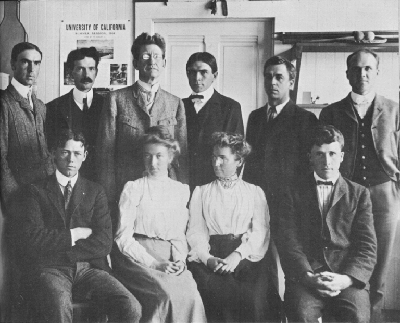
Staff and students of the Marine Biological Station at Coronado, 1904. Seated left to right: John F. Bovard, Effie Rigden Michener, Alice Robertson, Calvin O. Esterly. Standing: Robert Day Williams, B. D. Billinghurst, William E. Ritter, Loye H. Miller, Charles A. Kofoid and Harry Beal Torrey.
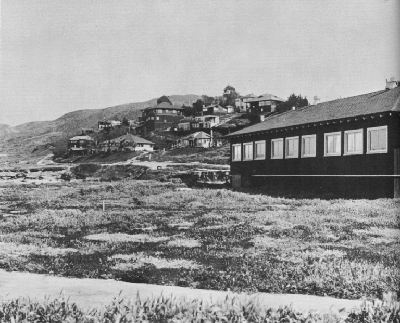
A part of the “village” of La Jolla overlooking the Cove with the Marine Biological Association's “little green laboratory” in the foreground. La Jollans donated the $992 it cost to build the laboratory, which was first used in the summer of 1905.
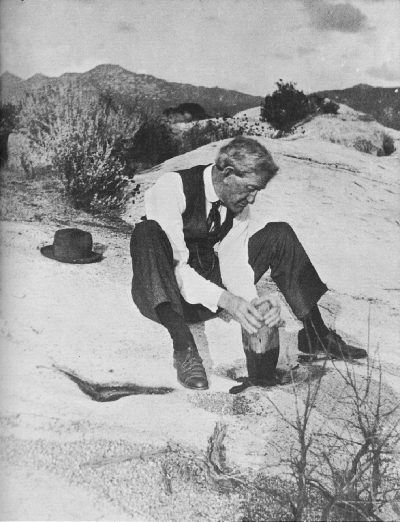
Director William E. Ritter, 1903–1923.
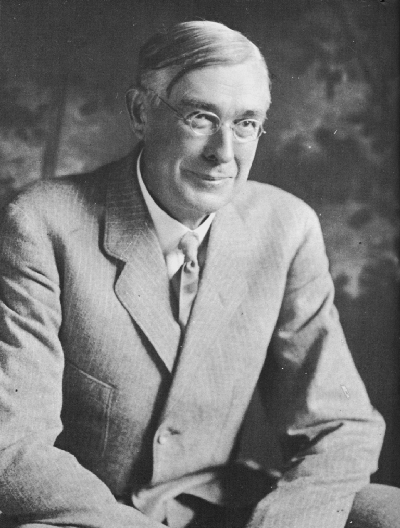
Dr. Fred Baker, San Diego physician, naturalist, and civic leader, who first invited Ritter to bring his biological studies to San Diego served as President of the Marine Biological Association for all but one year before the station was transferred to the University of California in 1912.
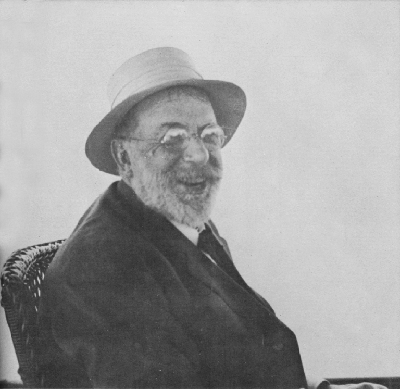
Edward Wyllis Scripps, instrumental in involving his sister, provided valuable support and guidance throughout the institution's early years and continued to help make important decisions until his death in 1926. (Photograph courtesy of Mrs. Harry L. Smithton)
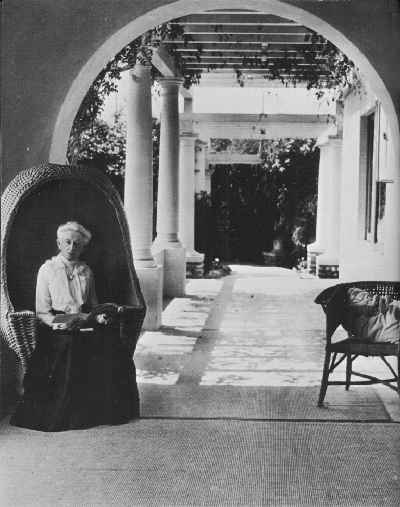
Miss Ellen Browning Scripps, who early was drawn into the activities of the Marine Biological Station, became its main source of financial support. An officer of the institution both before and after its transfer to the University of California, Miss Scripps helped to formulate policy and made possible many of the institution's scientific advances. She is pictured here in her La Jolla home, 1927. (Photograph courtesy of the La Jolla Historical Association)
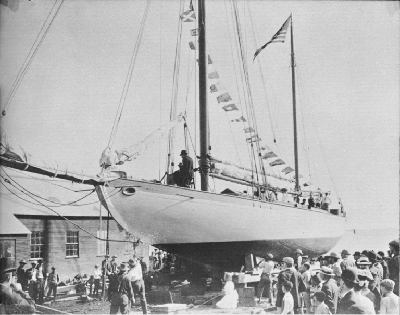
The Alexander Agassiz was built for the Marine Biological Station and launched in August, 1907, at San Diego.
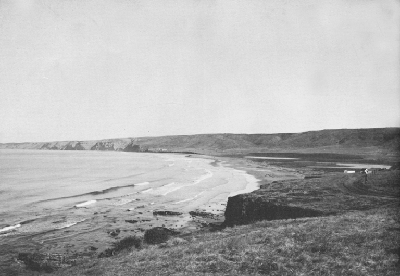
The tiny building in the far distance, left, is the first Scripps hall on the barren pueblo lot of 170 acres, sold for $1000 to the Marine Biological Association by the City of San Diego.
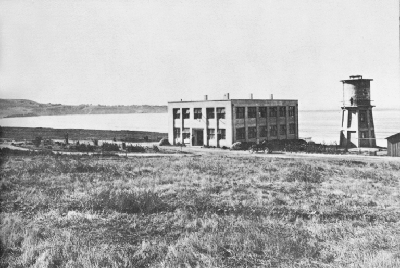
George H. Scripps building just completed in 1910, still in use in 1966.
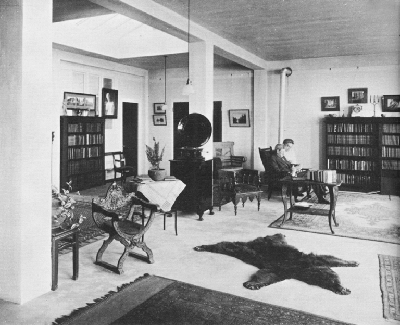
Dr. and Mrs. Ritter at home on the top floor of the George H. Scripps Building which, as the first building at the station, doubled as laboratory and residence.
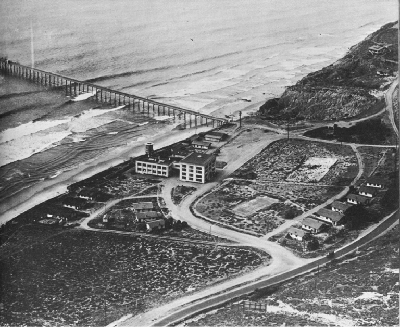
The Scripps Building, (center left, above) became the nucleus of a complex of buildings which by 1916 included the museum library (joined to the Scripps Building by a bridge), the aquarium (behind the two larger buildings above), the pier, the Director's home (on the triangle of land, above right) and housing for visitors and staff scattered over the hillside.
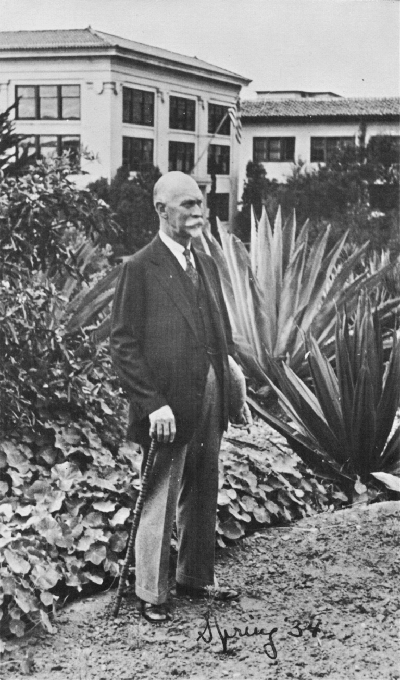
Thomas Wayland Vaughan, Director from 1924–1936, took great pride in his grounds and is pictured here in front of the library in the spring of 1934. (Photograph courtesy of Carolyn Vaughan Fortune)
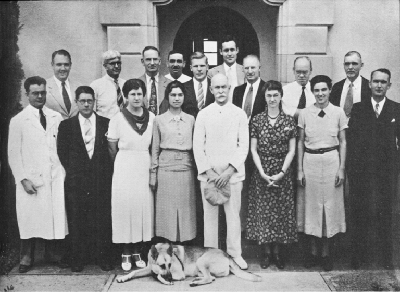
August 30, 1936. Back row, left to right: D. L. Fox, W. E. Allen, G. F. McEwen, James Ross, Richard Fleming, Roger Revelle, Martin Johnston, E. G. Moberg, F. B. Sumner. Front row: C. E. ZoBell, P.S. Barnhart, Easter Cupp, Tillie Genter, T. Wayland Vaughan, Ruth Ragan, Ruth McKitrick, S. W. Chambers, and Snooks.
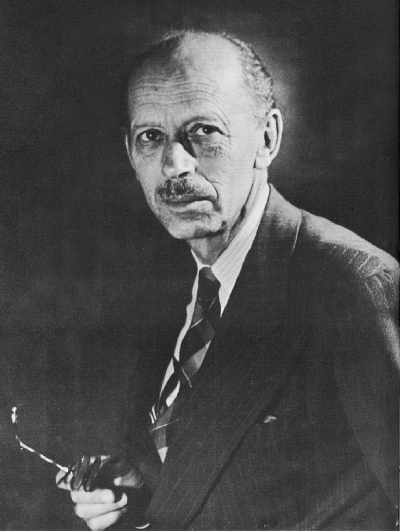
Director Harald U. Sverdrup, 1936–1948.
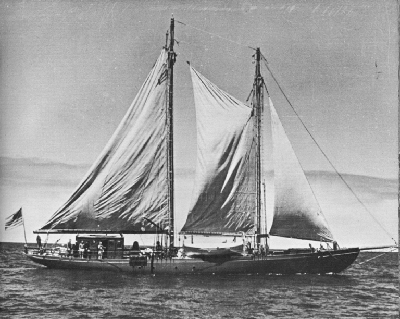
This romantic sailing ship was purchased in 1937, renamed the “E. W. Scripps” and made the first of the institution's long expeditions. The ship survived in the fleet until 1955 and then was used for the movie “Around the World in Eighty Days.” It now rests at the bottom of the Papeete Harbor.
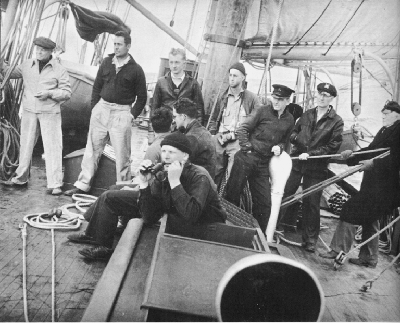
First long cruise of the E. W. Scripps into the Gulf of California in February, 1939. This picture is part of the group aboard at sea north of Cedros Island. Left to right: Erik Moberg, Roger Revelle, Seaman Andrew Boffinger, Richard Fleming (with binoculars), Machinist Bob MacDonald, UCLA Botanist George Hale, UCLA Botanist Lee Haines, Engineer Walter Robinson, Martin Johnson, UCLA Ornithologist Loye H. Miller. Not in the photograph, Captain Earl Hammond, Anthropolgist Harry Allen, José and Ernest Roque. Director Harald Sverdrup joined the group at Guaymas.
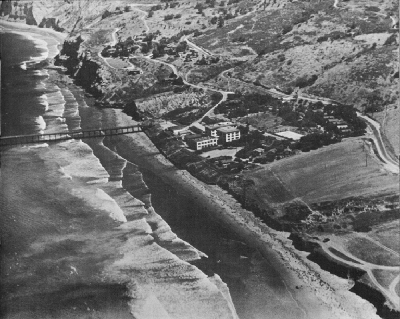
Scripps Institution of Oceanography in 1938, before World War II.
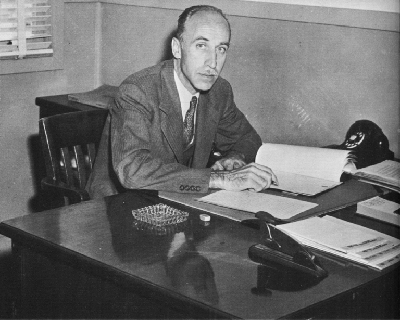
Director Carl Eckart, 1948–1950. (Photograph courtesy of Navy Electronics Laboratory)
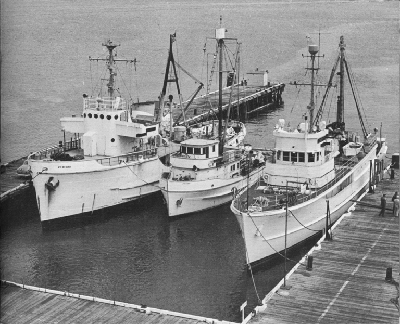
These new ships, left to right Horizon, Paolina T, and the Crest were added to the fleet in 1948.
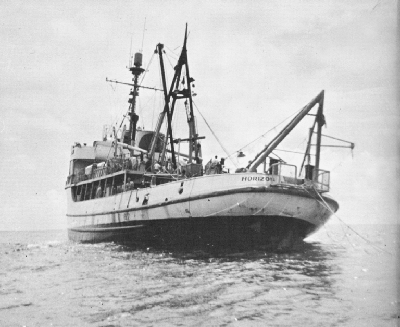
July, 1950—The HORIZON steams off on operation Mid-Pacific, first of the institution's major exploratory expeditions, carried on jointly with Navy Electronics Laboratory and with a scientific staff recruited from several institutions. Mid-Pac logged 15,368 miles and marked a new era in oceanographic research.
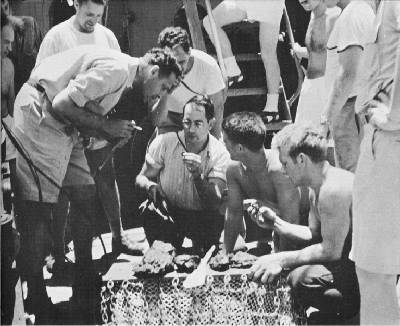
On board ship during operation “Mid-Pac”: Roger Revelle, leader of the expedition, left, Robert Dietz, Edwin Hamilton, Kenneth Emery, Robert Dill and others examine a dredge haul of rocks brought up from the mid-Pacific mountains, an undersea range southwest of the Hawaiian Islands, which was discovered on this expedition.
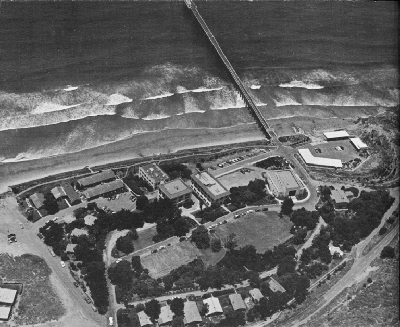
Scripps Institution of Oceanography in 1952. The Thomas Wayland Vaughan Aquarium Museum Building is on the right.
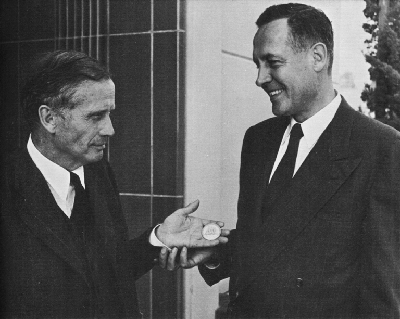
Roger Revelle, Director, 1951–1965, receiving the Albatross Award in 1954 from Professor Hans Pettersson, famous Swedish oceanographer.
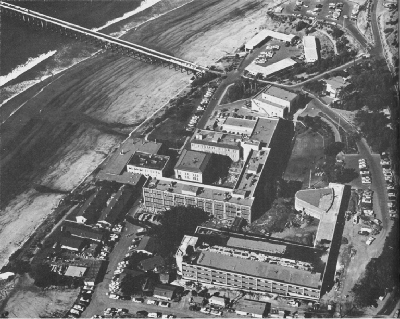
These new additions to Scripps Institution of Oceanography by 1959 show the huge post-war development of the Institution. At this time the fleet numbers seven ships and long expeditions of the Institution's ships around the world totalled 439,988 miles.
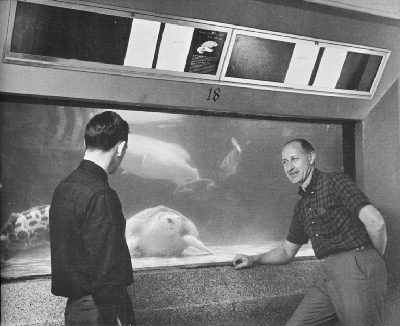
Fred Spiess (right), acting Director 1961–1963, Director 1964–1965, is talking with Donald Wilkie, Curator of the Thomas Wayland Vaughan Aquarium-Museum.

FLIP, Floating Instrument Platform is returning to the horizontal. When in the vertical position she displays only 55 feet of her total 355-foot length. FLIP has no motive power of her own, is towed to station.
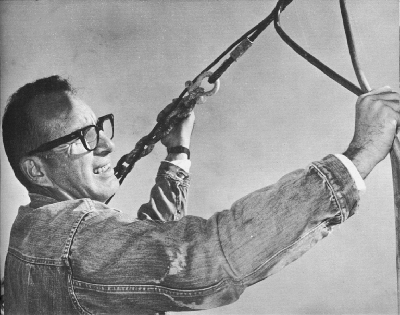
William A. Nierenberg, who became Director in 1965.
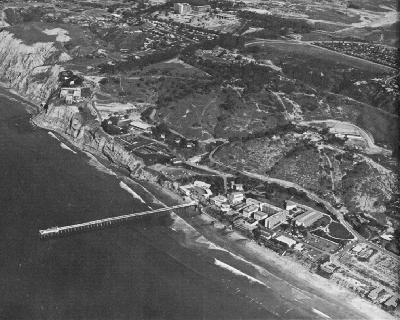
Scripps Institution of Oceanography in 1966 with Revelle College in the distance. Scripps is now part of the University of California San Diego campus.
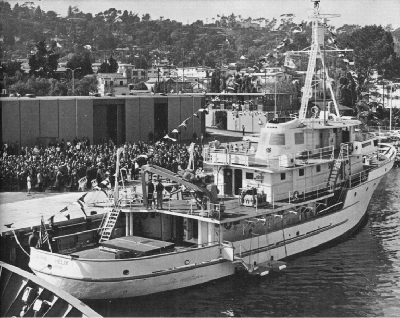
The newest research vessel, Alpha Helix, is shown here at the dedication ceremonies of the Scripps Marine Facility, the Alpha Helixand the Thomas Washingtonon March 11, 1966. This new ship is an ocean-going laboratory that provides a modern fully equipped biological station for work in any part of the world.
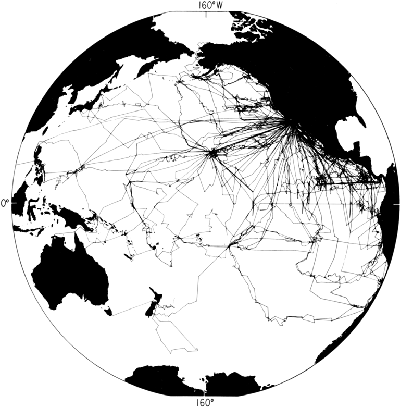
Chart track of the exploration by ships of the Scripps Institution of Oceanography 1950-mid 1965. (Courtesy of Dr. Robert L. Fisher)
